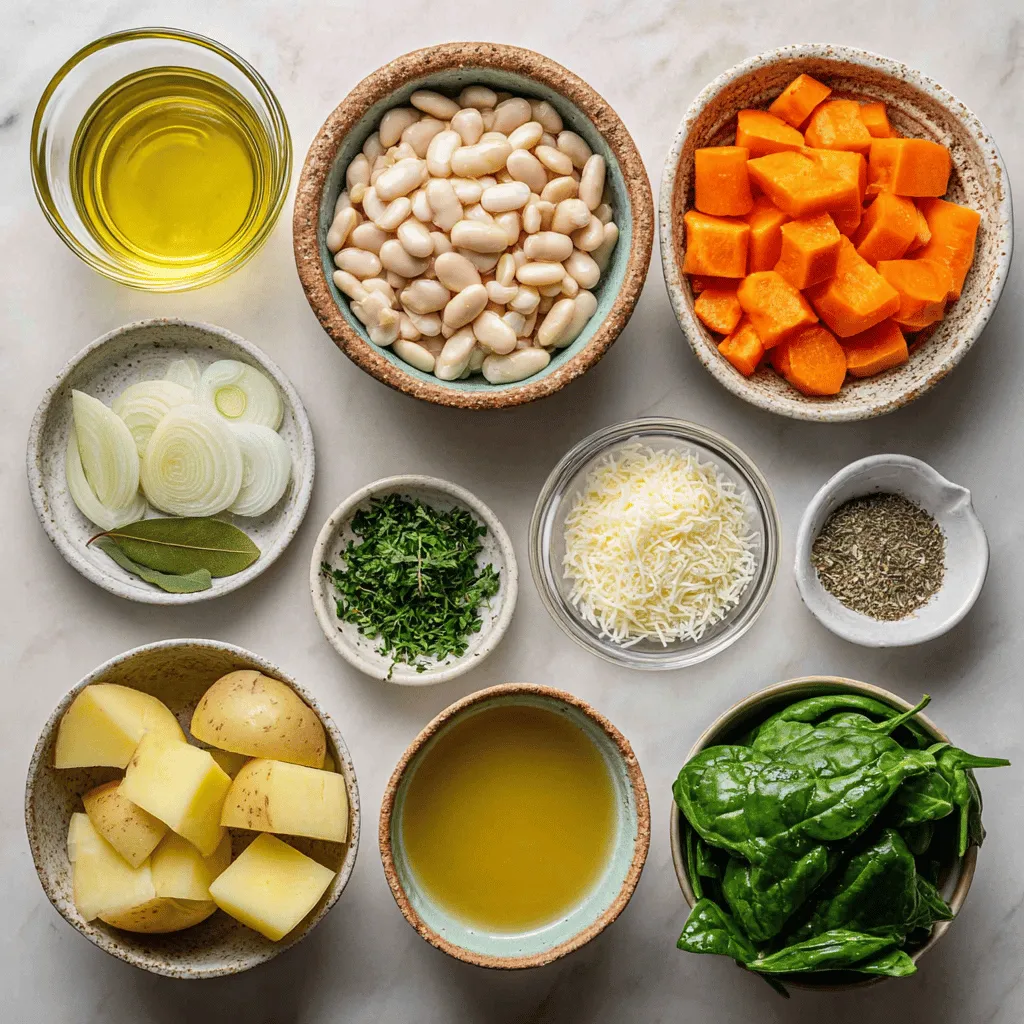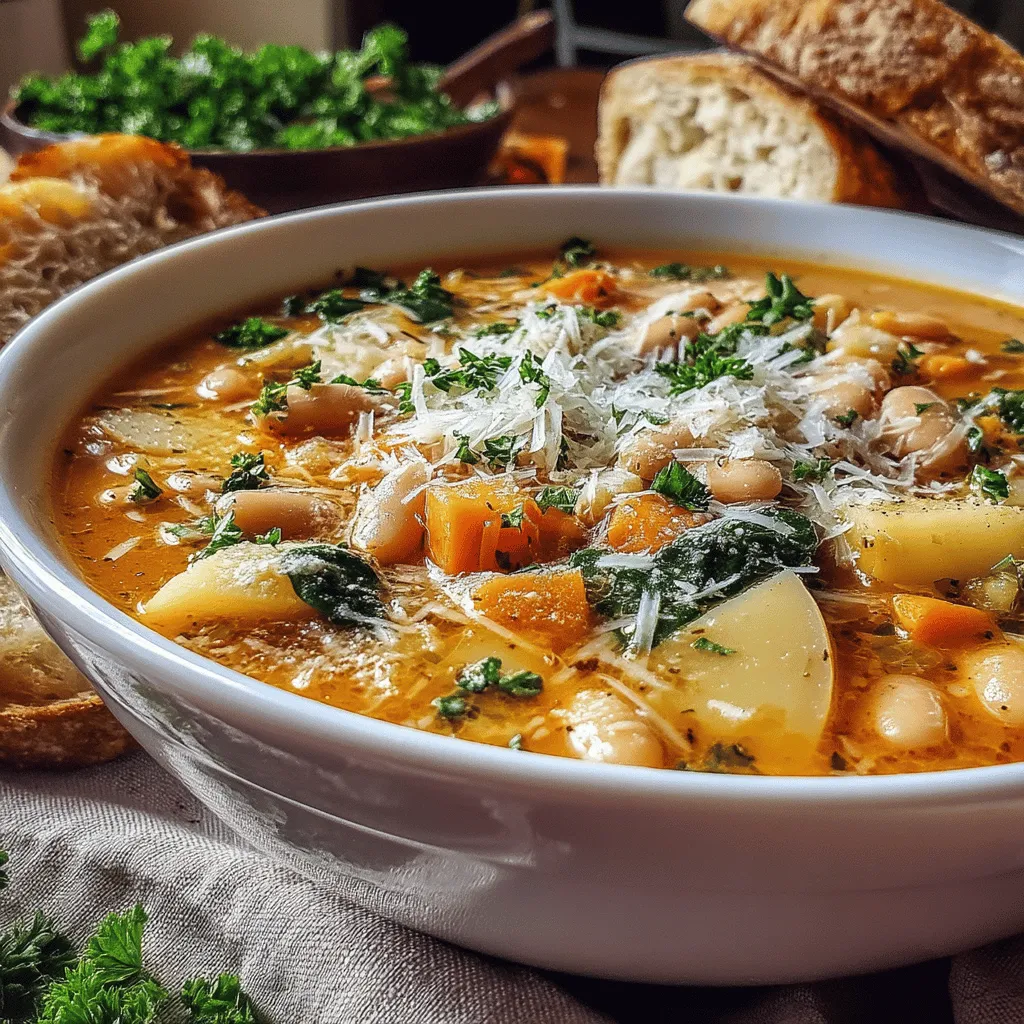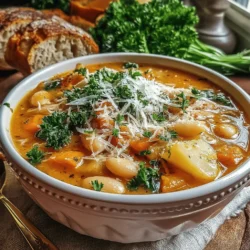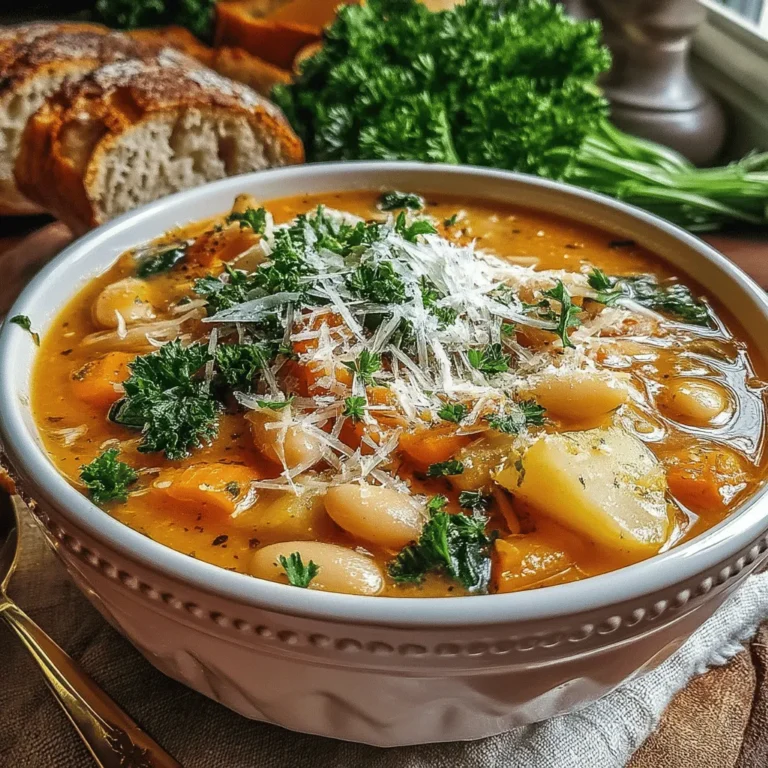Introduction
There’s something undeniably comforting about a warm bowl of white bean soup. This hearty dish not only warms your body but also nourishes your soul, making it a perfect choice for chilly days. The creamy texture and rich flavors invite you to slow down and savor each spoonful, turning a simple meal into a delightful experience.
White beans, the star of this soup, come packed with nutritional benefits, including high protein content and essential vitamins. With the inclusion of fresh vegetables and aromatic herbs, this recipe is not just delicious but also a wholesome addition to your diet. Slow cooking the ingredients allows the flavors to meld together beautifully, resulting in a dish that’s both easy to prepare and incredibly satisfying.
Recipe Overview
– Total Time: 8 hours (slow cooker)
– Servings: 6
– Difficulty: Easy
Ingredients
– 1 pound dried white beans (cannellini or great northern)
– 1 medium onion, diced
– 3 cloves garlic, minced
– 2 carrots, diced
– 2 celery stalks, diced
– 2 medium potatoes, diced
– 6 cups vegetable broth
– 1 teaspoon dried thyme
– 1 teaspoon dried rosemary
– 1 bay leaf
– Salt and pepper to taste
– 2 cups fresh spinach (optional)
– Juice of 1 lemon
– Grated Parmesan cheese for serving

Instructions
1. Rinse the dried white beans under cold water and remove any debris.
2. Soak the beans in a large bowl of water overnight, or use the quick soak method by boiling them for 2 minutes, then letting them sit for 1 hour.
3. In a slow cooker, sauté the diced onion, garlic, carrots, and celery on the sauté setting until fragrant and just tender.
4. Add the soaked beans, diced potatoes, vegetable broth, thyme, rosemary, bay leaf, salt, and pepper to the slow cooker.
5. Stir to combine all ingredients, ensuring the beans are submerged in the liquid.
6. Cover and cook on low for 6-8 hours or until the beans are tender.
7. If using, stir in the fresh spinach during the last 10 minutes of cooking.
8. Before serving, remove the bay leaf and stir in the lemon juice. Adjust seasoning with additional salt and pepper if needed.
9. Serve hot, garnished with grated Parmesan cheese.
Understanding the Ingredients
Dried white beans are not only the main ingredient in this soup but also a powerhouse of nutrition. Cannellini and great northern beans are rich in protein, fiber, and essential vitamins, making them excellent choices for a healthy diet. Soaking the beans before cooking enhances their texture and digestibility, ensuring a creamy soup without the grittiness.
Vegetables like onion, garlic, carrots, celery, and potatoes not only contribute to the overall flavor but also add vital nutrients. Onion and garlic provide antioxidant properties, while carrots and celery are packed with vitamins and minerals. The herbs and spices—thyme, rosemary, and bay leaf—elevate the soup’s flavor profile, infusing it with aromatic depth that complements the beans beautifully.
For an added nutritional boost, consider incorporating fresh spinach. This leafy green not only enhances the soup’s color but also brings additional vitamins and minerals. Finally, a splash of lemon juice brightens the flavors, while a sprinkle of Parmesan cheese adds creaminess, making this white bean soup an irresistible dish.

Tips for Adjusting Seasoning During Cooking
When preparing the Warm Hearth White Bean Soup, seasoning is key to bringing out the best flavors. As the soup simmers, taste at various stages to determine whether additional salt, pepper, or herbs are needed. Remember that the flavors will intensify as the soup cooks, so start with a modest amount of salt and gradually add more if necessary. This approach ensures that you don’t overpower the natural taste of the beans and other ingredients.
Cooking Process
Slow Cooking Methods: Low vs. High Settings
Using a slow cooker to prepare this soup can yield excellent results. Opting for the low setting allows the flavors to meld beautifully over several hours, creating a rich, hearty dish. Conversely, the high setting is suitable for those in a hurry, but it may not achieve the same depth of flavor. Regardless of the setting chosen, ensure that the beans are fully cooked before serving.
Explanation of How Cooking Times Affect Texture and Flavor
The cooking time is crucial for both texture and flavor. Longer cooking times on low heat will produce a creamier soup, as the beans break down more. If using the high setting, keep an eye on the time, as beans can become mushy if overcooked. Aim for a balance where the beans are tender but still hold their shape.
Indicators of Readiness: How to Know When the Soup is Done
To determine if your soup is ready, look for tender beans that have absorbed the flavors of the broth and other ingredients. A good indicator is when the beans can be easily mashed with a fork, yet still maintain some structure. The soup should be thick and creamy, with a pleasant aroma wafting through your kitchen.
Tips for Checking Bean Tenderness
Regularly check the beans as they cook, especially during the last hour. Take a small spoonful and taste. If they are still firm, allow for additional cooking time. Always remember that beans can vary in cooking times depending on their age and type, so patience is key.
Finishing Touches
Incorporating Greens Before Serving
Adding greens to your soup not only enhances the nutritional value but also adds a pop of color. Spinach is an excellent choice; it wilts quickly and complements the flavors of the soup beautifully.
How to Properly Add Spinach for Optimal Texture
To achieve the best texture, add fresh spinach just a few minutes before serving. This prevents it from becoming overly wilted and maintains its vibrant green color. Stir gently to ensure even distribution without breaking down the leaves.
Final Flavor Adjustments: The Significance of Tasting
Before serving, taste your soup again for any final adjustments. This is your chance to balance the flavors, so don’t hesitate to add a pinch of salt, a dash of pepper, or a squeeze of lemon juice for brightness. Each ingredient plays a vital role in creating a well-rounded dish.
Balancing Flavors with Additional Salt, Pepper, or Lemon Juice
A small amount of acid, like lemon juice, can elevate the soup’s profile. Start with half a teaspoon and adjust according to your taste preferences. This simple addition can make a significant difference in flavor, enhancing the overall experience.
Serving Suggestions: Presentation and Garnishing Ideas
Serve your Warm Hearth White Bean Soup in rustic bowls to emphasize its hearty nature. Top with freshly grated Parmesan cheese and a sprinkle of chopped parsley for a beautiful presentation. A drizzle of olive oil can also add visual appeal and a hint of richness.
Importance of Garnishing with Parmesan and Parsley
Garnishing with Parmesan not only adds a salty, umami flavor but also provides a creamy finish. Parsley adds freshness and a contrasting color that makes the dish visually inviting. These simple garnishes can elevate your soup from good to exceptional.
Nutritional Information
Breakdown of Calories, Protein, Fiber, and Other Nutritional Components Per Serving
A single serving of Warm Hearth White Bean Soup typically contains approximately 230 calories, with 12 grams of protein and 8 grams of dietary fiber. It’s a nourishing option that is low in fat while being rich in complex carbohydrates, making it a fulfilling meal choice.
Health Benefits of Consuming Bean-Based Soups
Bean-based soups are an outstanding source of plant-based protein and fiber, promoting satiety and aiding digestion. Additionally, they are packed with essential vitamins and minerals, contributing to overall health and well-being. Regular consumption can support heart health and help maintain balanced blood sugar levels.
Variations and Adaptations
Exploring Different Ingredient Substitutions
Feel free to experiment with different beans, such as navy or cannellini beans, based on your preference. You can also incorporate additional vegetables like carrots, celery, or bell peppers for added flavor and nutrition.
Options for Vegetarian or Vegan Adaptations
For a vegetarian or vegan version, simply omit any meat-based broth and use vegetable broth instead. This variation retains the hearty essence of the soup without compromising flavor.
Suggestions for Additional Flavor Enhancers
Consider adding bay leaves, thyme, or smoked paprika to deepen the flavor profile. These herbs and spices can transform your soup into a uniquely flavored dish that excites the palate.
How to Incorporate Different Spices or Vegetables Based on Preference
Adapt the soup to suit your taste by adding spices like cumin for warmth or red pepper flakes for heat. You can also include seasonal vegetables, ensuring that your Warm Hearth White Bean Soup remains versatile and adaptable year-round.
Conclusion
Warm Hearth White Bean Soup embodies comfort and nourishment, making it an ideal meal for any occasion. Whether you’re seeking a cozy dinner or a hearty lunch, this recipe promises to satisfy. Embrace the joy of home cooking by trying your hand at this delicious and wholesome soup, and relish the benefits of preparing food from scratch. Enjoy the warmth and satisfaction that comes from a bowl of homemade soup, and share it with loved ones for an even more fulfilling experience.

